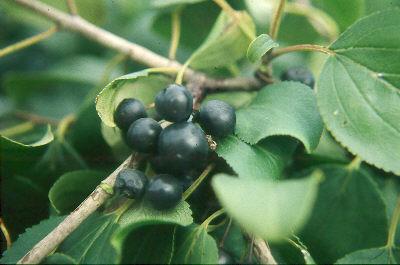I, and the rest of our clan, spend as much time as we can in our woods. Our time is split among harvesting trees and other forest products from the woods, having a good time, and keeping an eye on trees and property boundaries. Every time we are in the woods we watch for changes in the health of our trees, shrubs, plants and wildlife. We are also checking to make sure no new problem plants are moving into our land.
As vigilant as we are in walking the property lines and with all the work we do in our woods, we still missed an infestation of common buckthorn for a few years. It is not unusual when you have a lot of land or all your neighbors have a variety of invasive shrubs and plants. The infestation wasn’t big, but still required several years of treatment and monitoring before we felt comfortable that it was under control.
When we first found the main pocket of buckthorn it was about a quarter of an acre in size. We also found some smaller satellite pockets of buckthorn near the first infestation. We knew we needed to get on this right away before new pockets developed from seeds of the original.
Controlling invasive plants isn’t anything new to us, but not on a scale like this. Some of the buckthorn were large shrubs, and there was a high density of new seedlings underneath and a large quantity of seeds in the soil. We needed to attack this infestation in a number of ways.
This big infestation took us by surprise, and so we weren’t prepared to make a full on attack the first year. We needed to prioritize the limited time and resources we had. So, our first efforts were concentrated on the small satellite pockets of buckthorn. Our goal was to control these the first year and then deal with the larger pocket the following years.
We started by using a combination of pulling plants and spraying them with an herbicide. For the pockets with only a few, small plants, it was easy enough to just pull them carefully out of the ground without disturbing too much soil. Many invasive plant seeds will germinate better on disturbed soil, so we try to minimize the degree and extent of disturbance when pulling plants.
Where there were a lot of plants, we used an herbicide recommended for controlling buckthorn. Fortunately for us, it was late in the growing season, so we just waited for the native plants to go dormant and then treated the buckthorn which was still growing. Like non-native honeysuckle and garlic mustard, buckthorn will start growing before native plants have broken bud and will continue to grow after native plants have gone dormant.
In the past, our treatment of bigger shrubs was to cut them down with a chainsaw and treat the stumps with an herbicide. We had heard about using a basal bark treatment for buckthorn and decided to give that a try on the larger pocket. We contacted our local DNR forester and she walked us through how to use the tools and which herbicide to use. Basically, you mix the herbicide with an oil carrier in a backpack sprayer, and then thoroughly spray the bottom 12-15 inches of the stem and exposed roots and root collar.
The basal bark treatment turned out to be a great choice as it saved our backs from having to bend over to cut every shrub. And we had nearly complete kill of the shrubs we sprayed. Over the next few years, we would continue to treat the new seedlings that came up in the larger pocket until we could easily control their numbers by hand pulling.I would attribute our success in this effort to:
- Regular monitoring of our land to catch new infestations when they are small
- Attacking the small infestations first to keep them from getting big and then going after the larger infestations
- Using multiple tools and techniques to control or remove the plants
- Getting advice from an expert on the best ways to go about this
